
 |
Eager Space | Videos by Alpha | Videos by Date | All Video Text | Support | Community | About |
|---|

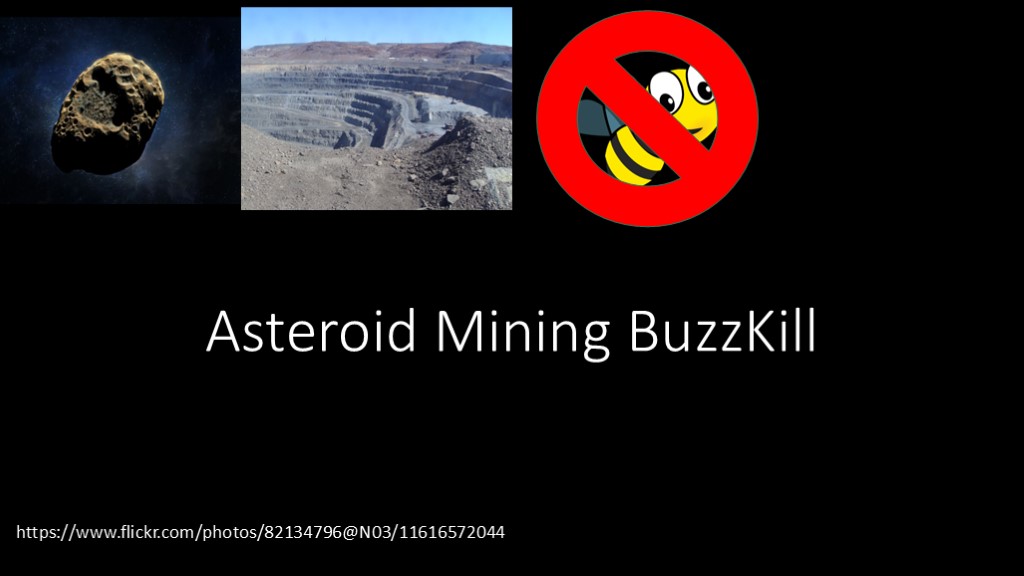
Hello. I've been seeing a number of articles about asteroid mining and some posts and lots of people telling me it's going to be great and there are millions, billions, or trillions of dollars out there to be made.
This is my contrary opinion which I'm calling asteroid mining buzzkill.
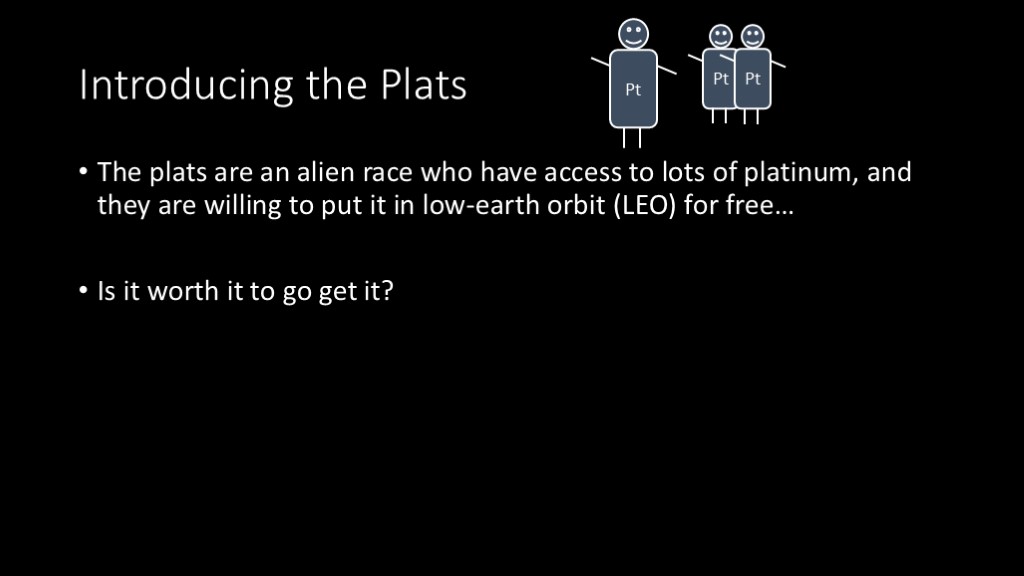
Now to start his discussion we need to introduce a couple of characters and I'm calling these characters the plats, and the plats are a group of helpful aliens.
In the first scenario, they're an alien race who really likes platinum - they have lots of it and they're willing to ship it to us and put it in low earth orbit for free for us to use.
The question is is it worth it to go get it?
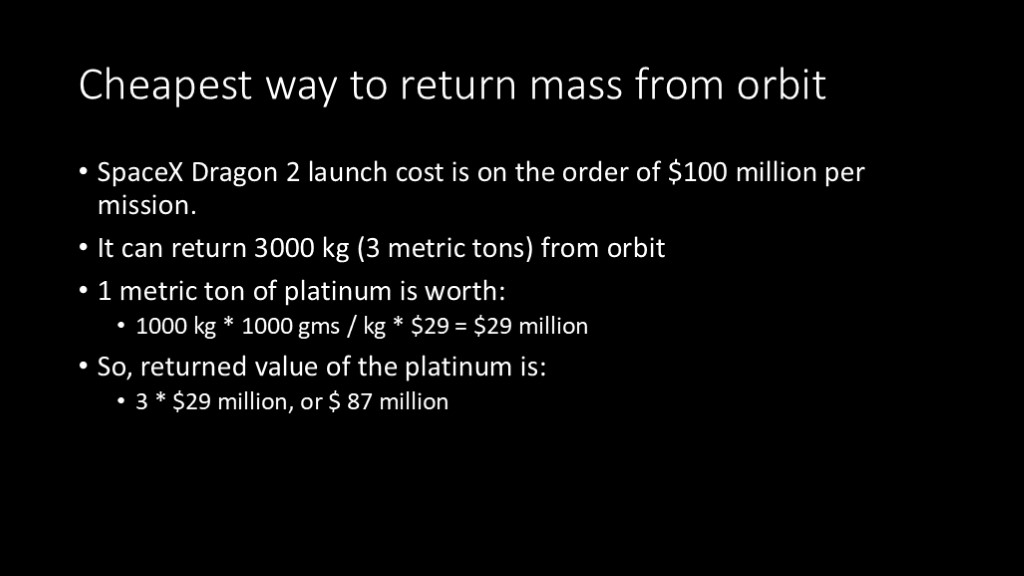
What's the most obvious way of doing this - what's the most cheap way we have right now of returning mass from orbit - and by cheapest way I means something that is operational, so SpaceX dragon 2 is probably the cheapest capsule out there with a launch cost on the order of $100 million per mission.
It can return 3000 kilograms or 3 metric tons from orbit.
Now if you go out and look at platinum, you'll see it's going for about $29 a gram now, and doing a little math, thousand grams per kilogram, a thousand kilograms per ton is worth about $29 million.
Dragon 2 can return three of those so three times $29 million or $87 million in totoal.
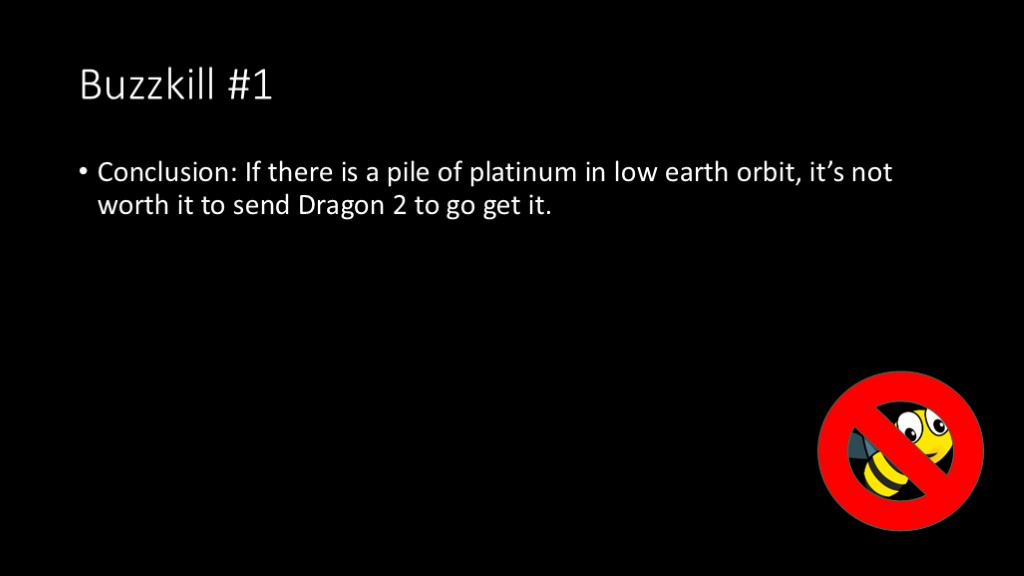
Buzz kill number one - if there's a pile of platinum in low earth orbit it's not worth it to send dragon 2 to go get it - it actually costs more than the money you would make from selling the platinum.
Now you can make arguments - maybe Dragon could be cheaper, maybe we could go with something else to get it, or maybe use something else to bring it back, something that's lighter and disposable, and sure you can do all those things, but with things that exist right now, since I talked about Dragon, here's the obvious question.
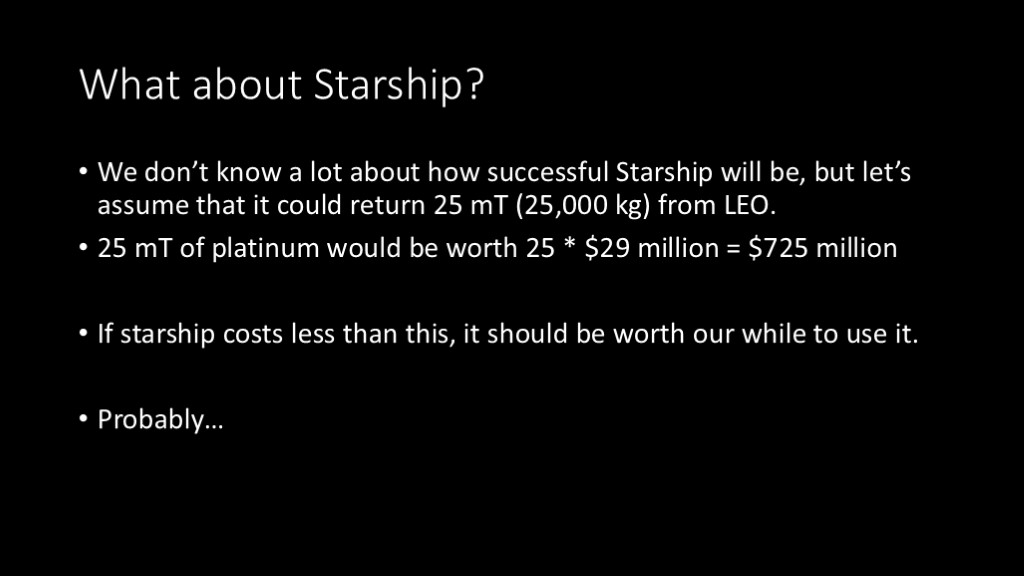
What about starship?
We really don't know right now a lot about how successful starship is going to be, but let's assume that it could return 25 metric tons from low earth orbit - which isn't really an unrealistic assumption so 25 metric tons of platinum would be worth 25 times $29 million and that's $725 million.
So if starship costs less than that, it should be worthwhile to use it.
Well, the real answer is probably...
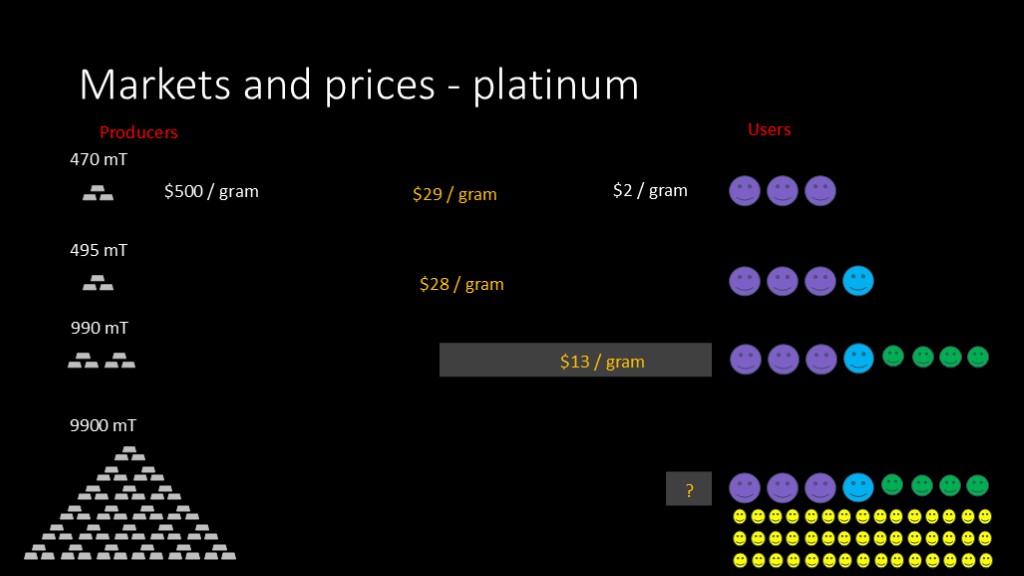
I need to switch and talk a little bit about markets and prices. We're going to be specifically talking about platinum but this applies to markets in general.
In a market we have someone who produces something like platinum - a company that mines and refines and sells refined platinum, and then we have users on the market and use it for whatever they make or whatever processes they do.
The produces have this platinum they want to sell and they'd like to sell if for a lot of money - let's say they say, "I'd like to get $500 a gram for it, that would be a really great business to be in, just think of the money we could make if we sold it for $500 a gram".
The producers want a high price.
The users on the other hand want a really low price so they're looking at how much platinum is costing us when we're using it. Wouldn't it be great if it only cost $2 per gram rather than what it costs now - just think of how much money we could make?
There's always an inherent tension between the people who are producing and the people who are using or consuming and what happens is based upon how much the produces can produce and how much the users really want it. We end up with an established price or what we call a market price, and if you go out to buy some platinum, that is what it costs you., about $29 a gram right now.
The tension here is that on the user side the people who are buying platinum are willing to pay $29 a gram, perhaps a discount based on buying a lot, but their price is based off of this market price. There might be more people on the user side who are willing to buy more if it was cheaper, and obviously if it got more expensive - if the price doubled - there would probably be fewer people who are willing to buy it.
It just wouldn't be worth it, and similarly on the producer side there are produces willing to produce if they could get more money for it - maybe there's some margin mines that would now become profitable and if they price went down they'd be willing to produce less.
It turns out that in platinum the worldwide market per year is about 470 metric tons, so you could multiply 470 metric tons times the amount per gram and you could figure out what the overall market was. That really doesn't matter.
Let's say we've now done a single starship mission and we've gotten 25 metric tons of platinum. So the question is now we have 495 total metric tons of platinum - there's a little more there - and we need buyers.
You look at this and say 25 metric tons out of nearly 500 metric tons total is a relatively small change in supply so it probably doesn't move the price around very much and I just threw a number at this - maybe it moves it to $28 a gram.
Maybe we push 25 metric tons of platinum onto the market and it really doesn't change the price. Maybe some of the produces say "hey, I'm going to close down some of my mines - it's not really worth it" and we might not see new buyers - maybe $28 a gram really isn't enough to attract new buyers. It's likely we'll see a shift down, but it's really hard to know what values you will actually see. There's probably somebody out there who is in the business of looking at precious metals and how the market's moving around, and they could probably give you a very good idea. I'm definitely not that person.
Let's say we fly a lot more starship missions and we start bringing back a lot more platinum, so now if we added what we brought and what the existing producers were already producing, we'd end up at 990 metric tons, or about double.
What does that mean? If we have twice as much platinum available we need to find a lot of new buyers because the existing buyers, maybe they can expand their business a little but that's something that generally doesn't happen really fast, so we need new buyers, and those buyers are buyers who were not interested in buying platinum at $28 per gram. They might be interested in something lower, so now that we've doubled the supply we are very likely going to reduce the price.
How much, I don't know so I threw in a band here - I actually don't know how much and every market is different and it depends so much on what other uses are available for platinum - for new businesses to start up or for existing businesses to expand or for platinum to be used instead of other materials.
It also depends a ton on how the producers view things internally - if we push the price down, some of the producers are going to say it's not worth it for me, so we may not actually end up with 990 metric tons - maybe we only end up with 800 because the lower price has driven some of the mining ones out of existence.
The answer is if you start making big changes to supply like this, who knows what the price is going to do but it's a fair guess it's going to drop. I threw in a number there - $13 per gram - it would not be surprising if you doubled the supply, you actually halve the price it's not like there's a rule - it might be $24 a gram or it might be $2 a gram - we really don't know.
Let's just say that you were very good at this and you had access to a whole lot of platinum and you brought home so much platinum that you're brining home 9900 metric tons. To sell that you need a whole lot of buyers - you're expanding that 10 times - what's the price? Once again, I don't know but it's going to be way way less than $29 a gram.
This illustrates one of the fundamental problems with the idea of asteroid mining; to make decent amounts of money you have to bring back a lot of material but when you bring back a lot of material you start distorting the markets and driving the price down, and it's very possible you could drive the price down far enough that you actually are not making money any more, which would really be an unfortunate thing to do.
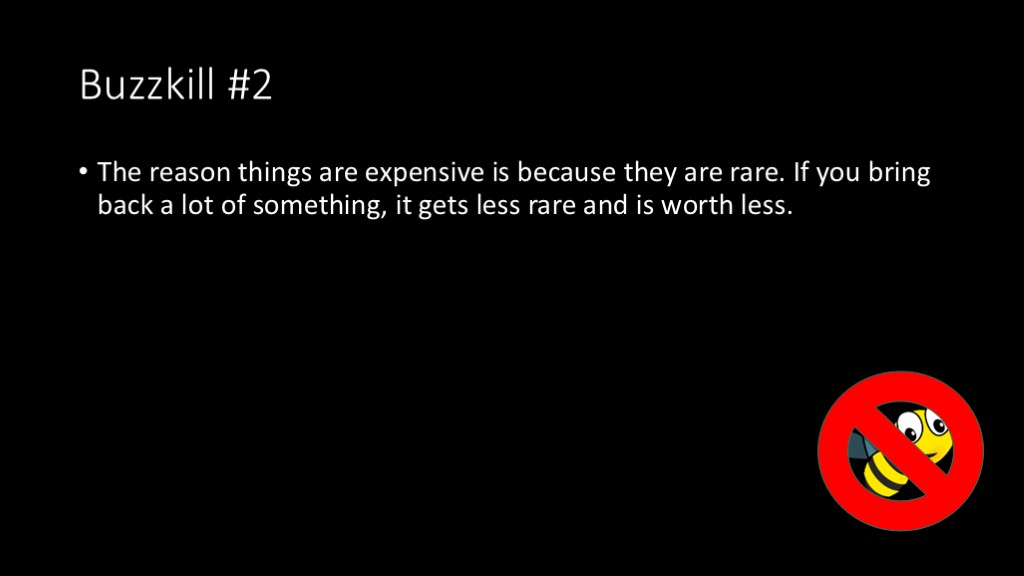
This is buzz kill number 2 - the reason things are expensive is because they are rare. If you bring back a lot of something, it gets less rare and it's worth less that it was before and you can easily find yourself with a business that just doesn't make sense.
We see this in a general case - if you look at the mining industry in generally you will see that there are some mines that it's fairly simple to extract whatever they're extracting and they tend to be profitable for a long period of time and insensitive to price fluctuations, but then there are other mines that are more on the edge, and it's really common if the price drops for a few years and that mine shuts up. Maybe if the price goes way up again then mine might reopen again.
Small changes in price can actually have big changes in profitability,
That was the low earth orbit - it's really a contrived example but I wanted to just show that even in the low earth orbit case, the economics really aren't that clear - it's not clear that you are going to make tons of money even in this contrived case.
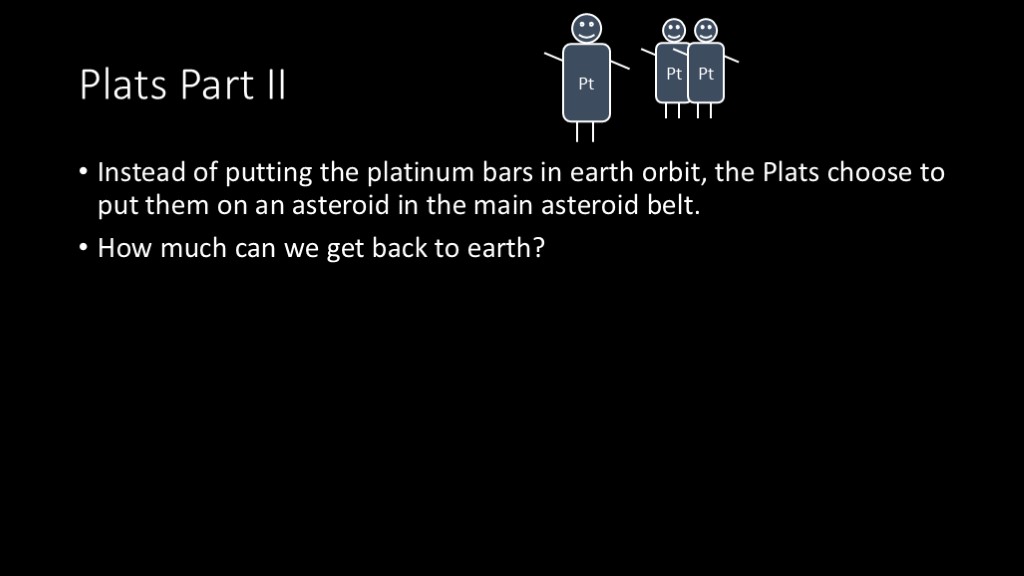
Now lets assume that the plats, instead of putting the platinum in low earth orbit which is obviously just really stupid, lets say that actually put it on an asteroid in the main asteroid belt. We've made our scenario a little clearer and a little more real life.
We now have to get out to the asteroids and get back so how much can we get back to earth?
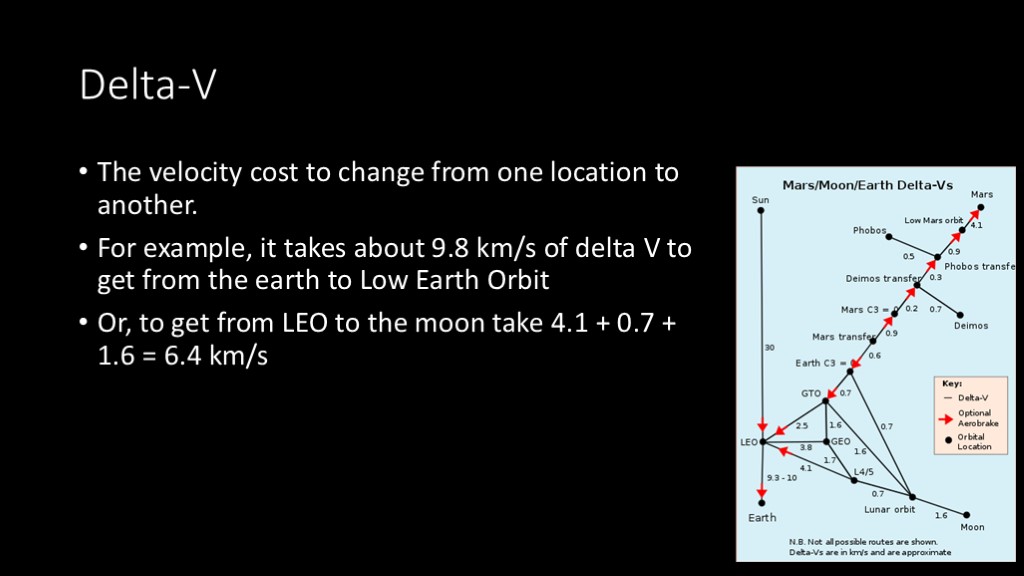
For this I need to take a little excursion into the world of delta v, and delta v is really simple - it's the velocity cost to change location from one location to another - how much do we have to change or velocity to get from the moon to lunar orbit or from earth orbit to mars or from earth to geosynchronous orbit.
All of those have a specific velocity cost in terms of the amount of energy it takes - you have to change your velocity enough to be into that orbit or to get from one location to another. If you look online you can find some really neat charts like this one that show you the delta v cost to get fro mone place to another.
If you look in the lower left between low earth orbit and earth, it says 9.3 to 10; generally the number I've heard is either 9.4 or 9.8 kilometers per second to get your payload from sitting on the earth's surface into low earth orbit, and if you look at some of the numbers there are a lot of numbers that are actually quite a bit smaller than that, and this is why it's really common to say that once you are in earth orbit, you're halfway to anywhere in the solar system.
If you want to go from earth orbit and land on the moon, we can just look at the various costs along the way - it's 4.1 and then 0.7 into lunar orbit and then 1.6 to land so your total cost from low earth orbit to land on the moon is about 6.4 kilometers per second. That's how much you need to change the speed of your vehicle along the way to achieve that, and obviously if you're on the moon, you want to come back. You need something similar coming back towards the earth.
You'll notice that there are some red arrows on this chart, and the red arrows show places where you have the option to aerobrake, which means you can put your vehicle that is going too fast into an atmosphere and use that to help slow you down. That means coming back from the moon won't take 6.4 kilometers per second if you aerobrake, and similarly we know coming back from low earth orbit to earth, you can do that in a capsule with a very small amount of delta v - you need enough to get out of orbit but then the vast majority of that nine point whatever is just dissipated as heat.
The point of showing this is that we can understand how much energy it would take to get from earth orbit out to the asteroids and then we can figure out what impact that has on the vehicles we might design to do that, and that takes me into spaceship design.
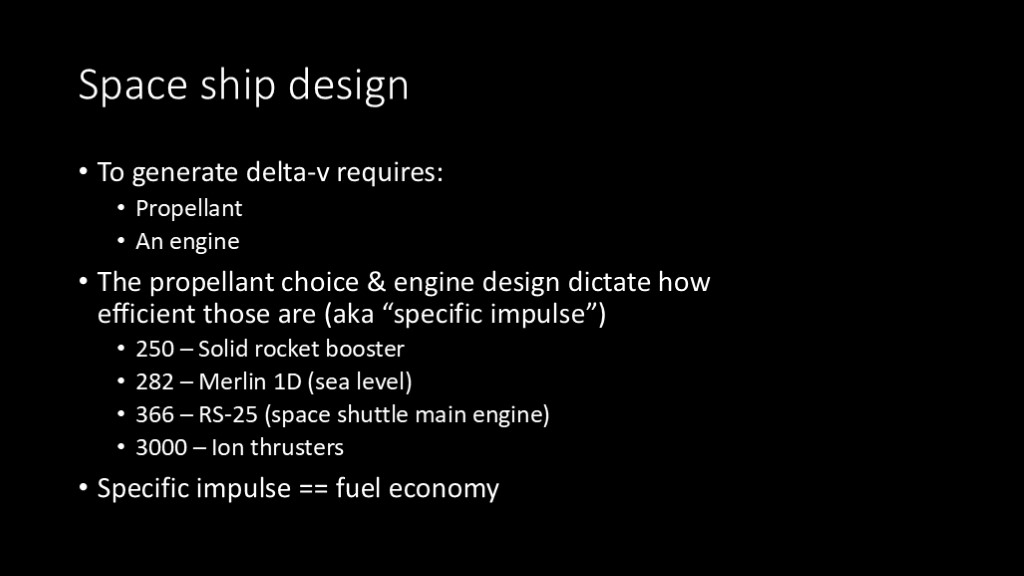
I'm not going to go deeply into this but there are a few principles that are important. To generate delta v requires some sort of propellant, so some sort of fuel or fuel and oxidizer, and it requires an engine.
The propellant choice and the engine design dictate how efficient those are and this is measured by a measurement known as specific impulse. If you look at solid rocket boosters, they have a specific impulse of about 250. The merlin 1D used on the Falcon 9 is about 282 at sea level. The RS-25s used on the space shuttle and SLS are about 366 at sea level. A different class of engines known as ion thrusters which are used to move satellites already in orbit are about 3000.
You can think of specific impulse as fuel economy. The better the specific impulse the more delta v you get from a specific amount of fuel.
Now that we have that we can go and talk about specifics to get from here to there.
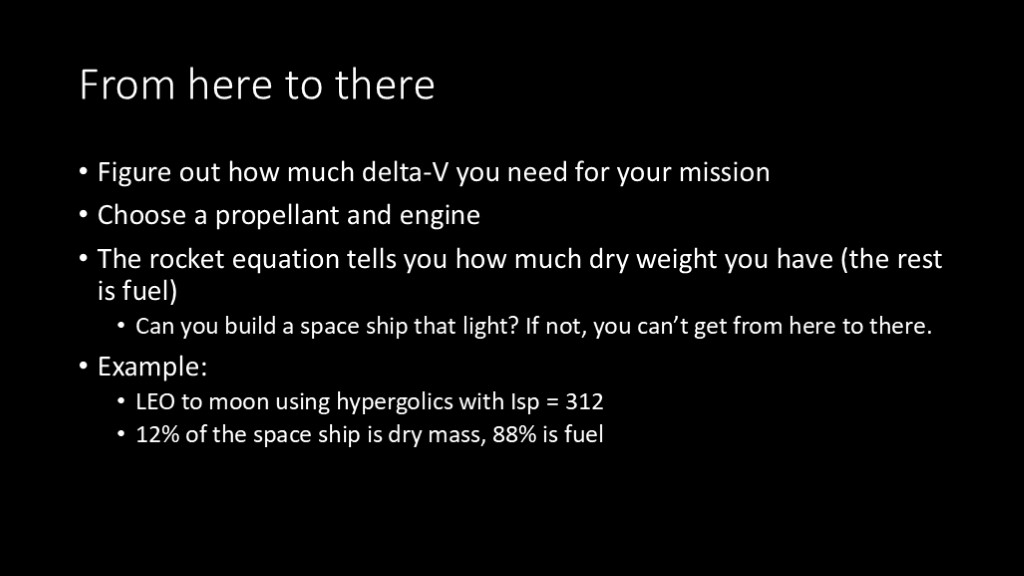
You need to figure out how much delta v you need for a mission, choose a propellant and engine based on a number of different factors, and then use the rocket equation to tell you how much dry weight you have (the rest is fuel).
If you can build a spaceship that's light enough to have your engines and your support structure and your fuel tanks and your payload - all the rest is fuel - then you can get there.
If not - if it's too heavy - then you can't get there from here, at least something with a specific size.
Let's take a little example. We're going to go to the moon, and we're going to use hypergolic fuels and a hypergolic engine with a specific impulse of about 312. If you plug that into a rocket equation calculator, you'll find that to do that 88% of your mass needs to be fuel and that leaves you 12% for drymass, 12% for all the structures and the engines and your payload.
This is called the tyranny of the rocket equation - basically it's saying that whenever you're using fueled rockets, the vast majority of your weight is going to be fuel.
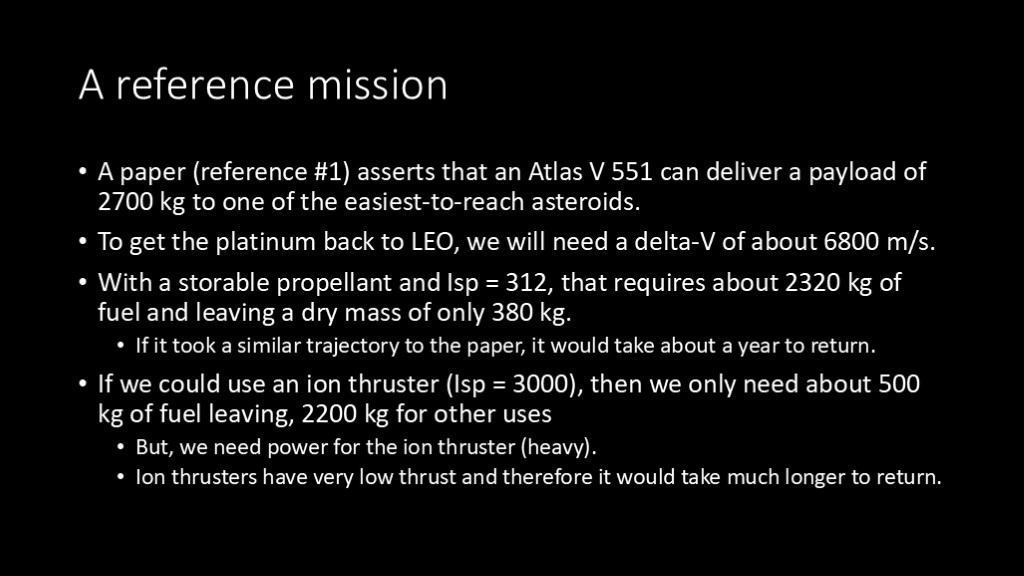
Keeping all that in mind, we're talking about going out to the asteroids, and rather than do all the calculations myself, I went and found a research paper that was exploring this very question, At the end of the video there's a slide with references to the study.
In this study they describe a bunch of asteroids that are easily reachable from the earth. They looked at at using the Atlas V in the 551 configuration, and their calculations say they can deliver a payload of 2700 kilograms to one of the easiest to reach asteroids - some asteroids are harder to get to, they require more delta v.
What would happen if we were trying to return something from one of those asteroids and we had 2700 kilograms to play with.
Based on this paper, the delta v to get back to earth is about 6800 meters per second. It's a fair bit of delta v.
Once again, we're going to go with a storable hypergolic propellants with and specific impulse of 312. That means we need 2320 kilograms of fuel, and that would leave us with a dry mass of only 380 kilograms, which really isn't a lot.
I didn't do the aerobraking version - aerobraking might let us cut this down some, but the basic principle still applies - mostly fuel, just a little bit of dry mass, and that dry mass is all of the probe - all the engines, all the fuel tanks, all the electronics, everything we need. The payload is just whatever we have left after all those other things.
If we took a similar trajectory used by the paper to get to the asteroids, it takes about a year to get back.
We could switch over and use ion thrusters - the specific impulse is much and the numbers look better - you only need 500 kilograms of fuel and that's leaving 2200 kilograms for other uses. That seems great, you should definitely use ion thrusters.
But you need power for ion thrusters and that probably means a big solar array that we'll have to carry and that adds a fair amount of weight. Ion thrusters are very low thrust and that means it will take quite a bit longer to return. Elapsed time really matters, and if I'm trying to design this as a business, I've spent all this money up front and I finally get to the point where I can launch, and it takes a year to get all the way out there. In the first example, it takes a year to get back and that means I've two years from launch before I see anything, and from a monetary return perspective, that's not great. You'd prefer to get money coming in as quickly as possible and if ion thrusters push that out farther, it makes the investment less attractive.
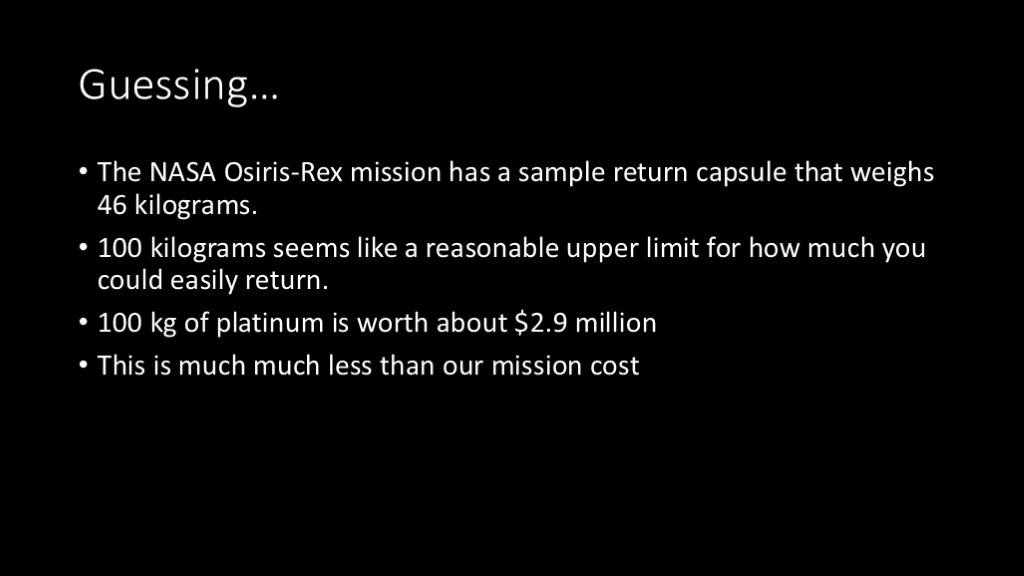
Now I need to do a bit of guessing around how much material we could likely bring back.
NASA just did a mission all Osiris rex where they rendezvoused with an asteroid. Their sample return capsule weights 46 kilogram.
100 kilograms seems like a reasonable upper limit for how much you could easily return - it's a conservative guess , not a rigorous guess but in the right ballpark.
100 kilograms of platinum is worth about $2.9 million, which is much less than our mission cost.
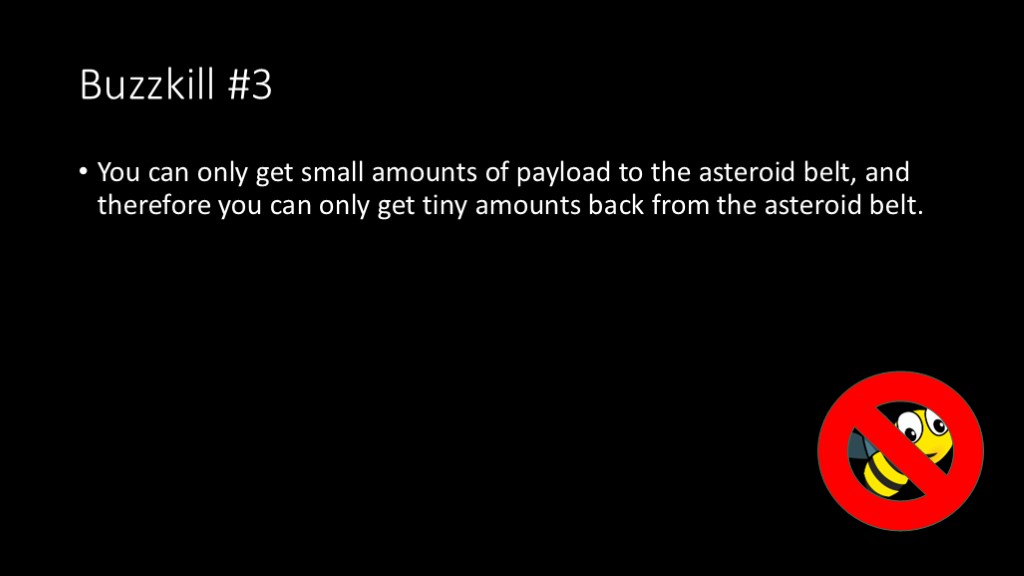
Bringing stuff back from the asteroid belt is just hard - you can't get a lot of material there with current technology, and therefore you can only get tiny amounts back.
That's buzzkill #3.
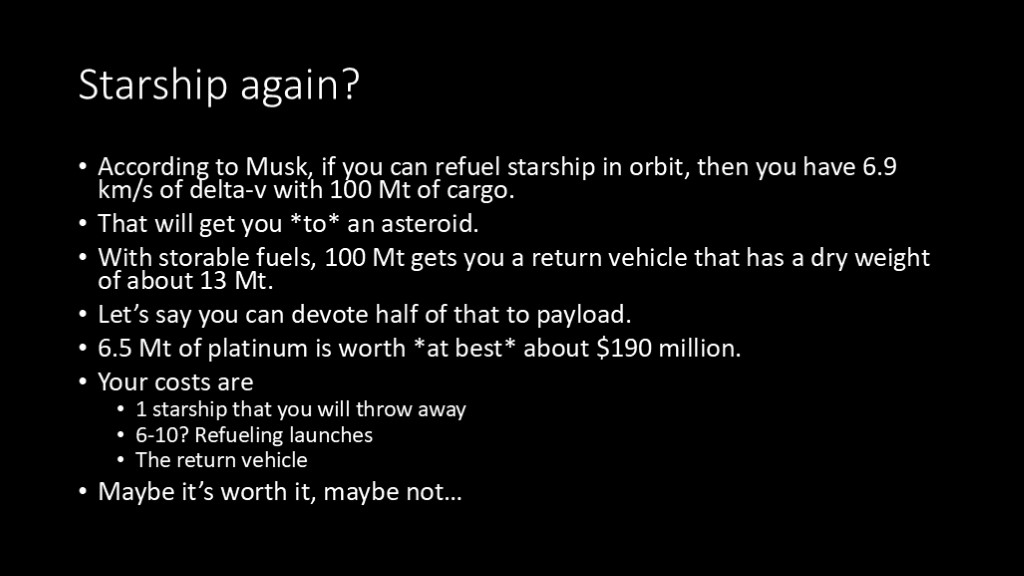
What about starship?
Based on what musk has said, if you can refuel starship in orbit then you can have 6.9 kilometers per second of delta v with a full 100 metric tons of crag. That's interesting - that's a really large amount of cargo for that much delta v.
I you cut down the cargo - cut down to 50 tons - then maybe you can get all the way up to 10 kilometers per second, so that gives you a lot of options.
Let's assume that we do that. That get6es you to an asteroid with that much cargo, and let's assume the same hypergolic storable fuels. 100 metric tons ge6ts you a return vehicle with a dry weight of about 13 metric tons, and lets assume we get half of that as payload.
That gets us six and a half metric tons of platinum, and at $29 a gram, that's worth about $19 million and six and a half metric tons probably isn't enough to distort the market much, so it's probably pretty close to something like that in your costs.
You have a starship you've taken out there and you've thrown away, to have some number of refueling launches - six launches, ten launches - and then you have to develop and build the return vehicle and figure out how to get the platinum back down at the other end, so maybe it's worth it, maybe it isn't. I think you can see worlds where starship is really cheap and you can do it for quite a bit less than $190 million, and you can see worlds where starship isn't quite that cheap and you can't d it

I'm going to assert that even using starship to get there it's marginal, or at least with what we can guess about starship.
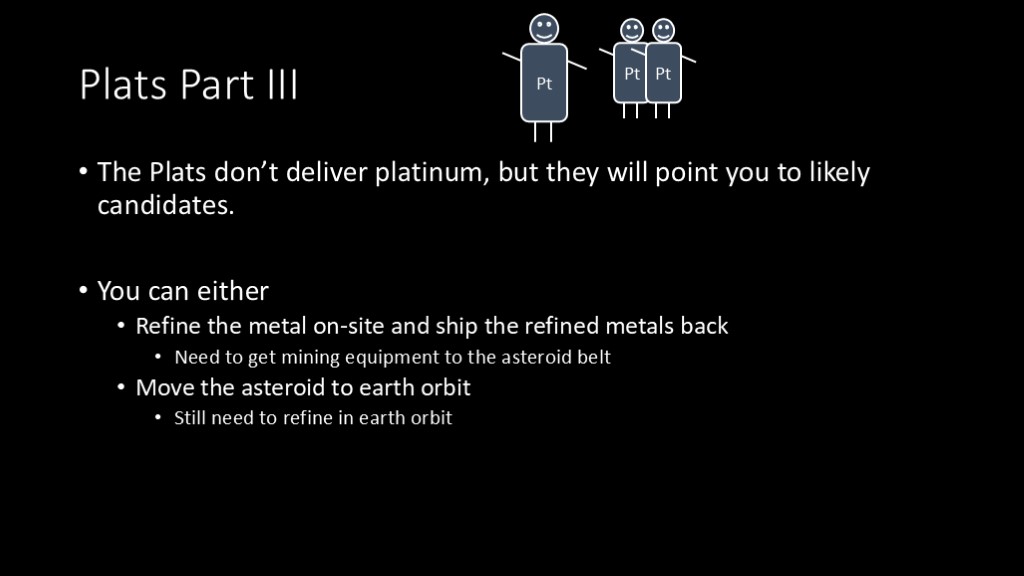
Let's go back to our aliens - here's Plats part III. They're kind of tired and aren't excited about delivering platinum themselves but they can point you to likely candidates - they can say "if you go to this asteroid, that would be a pretty good bet" - and to be fair, we already know this kind of thing without the plats.
How would we deal with this situation?
We can either refine the metal on site and ship the refined metals back, and to do this we obviously need to get the mining equipment to the asteroid belt, or you can move the asteroid back into earth orbit and do the mining there.
Let's talk about the first option.
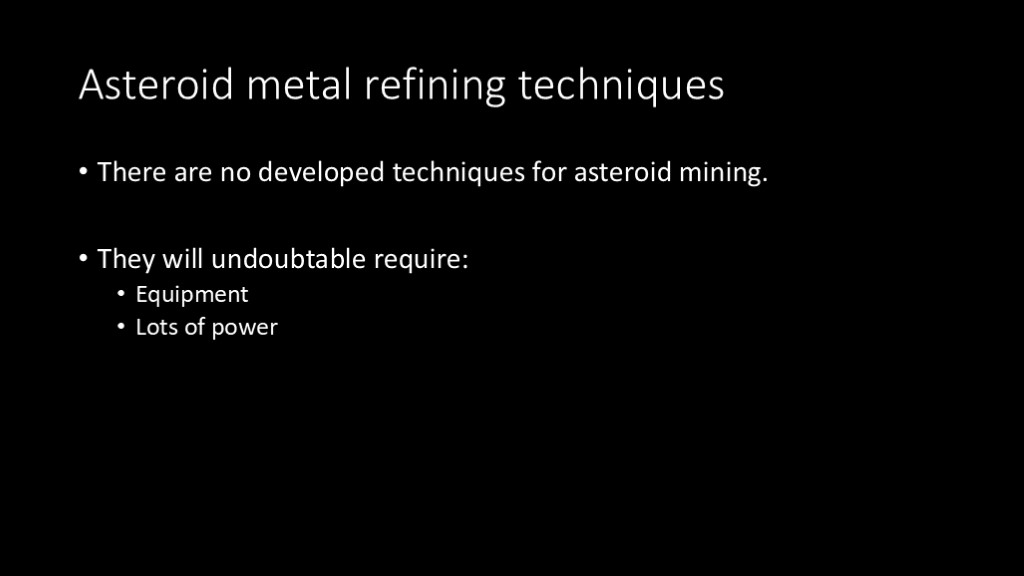
There aren't any.
There's nothing developed for this - there are a number of speculative approaches, but this is not going to be an easy thing to do. Whatever approach is chosen it will undoubtably require equipment and probably heavy equipment and it will require lots of power.
Both of these are pretty expensive to get out to the asteroid belt.
Lots of power would either need lots of solar cells or probably need some sort of nuclear solution and even if you can do that as a private company, nuclear is not going to be cheap.
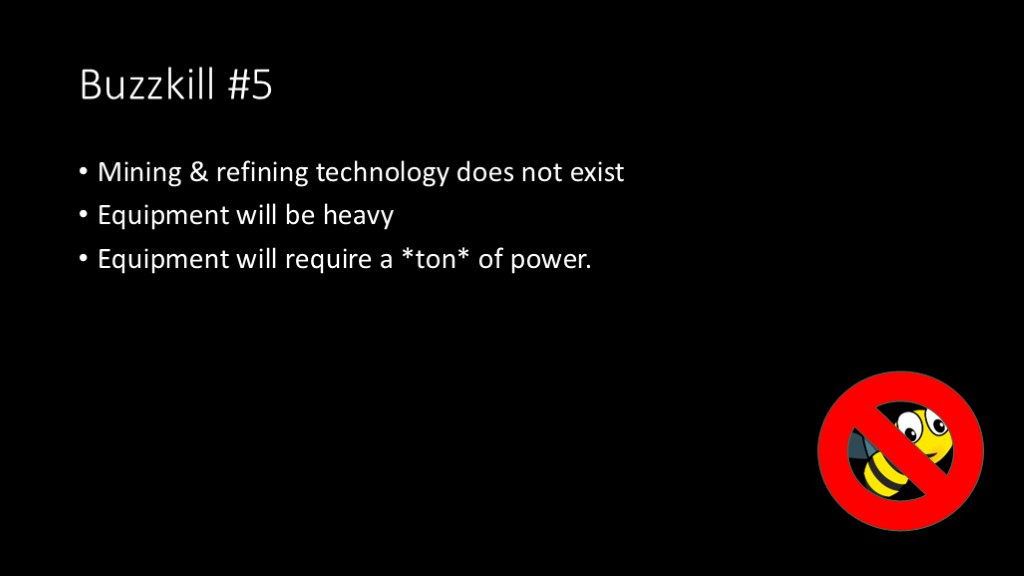
Those are the options, so buzzkill #5 we don't have the technology, it will be very expensive to get the equipment out there and the equipment will require a ton of power, not to mention we still have to take the refined stuff and get it back, and we already known that's problematic.
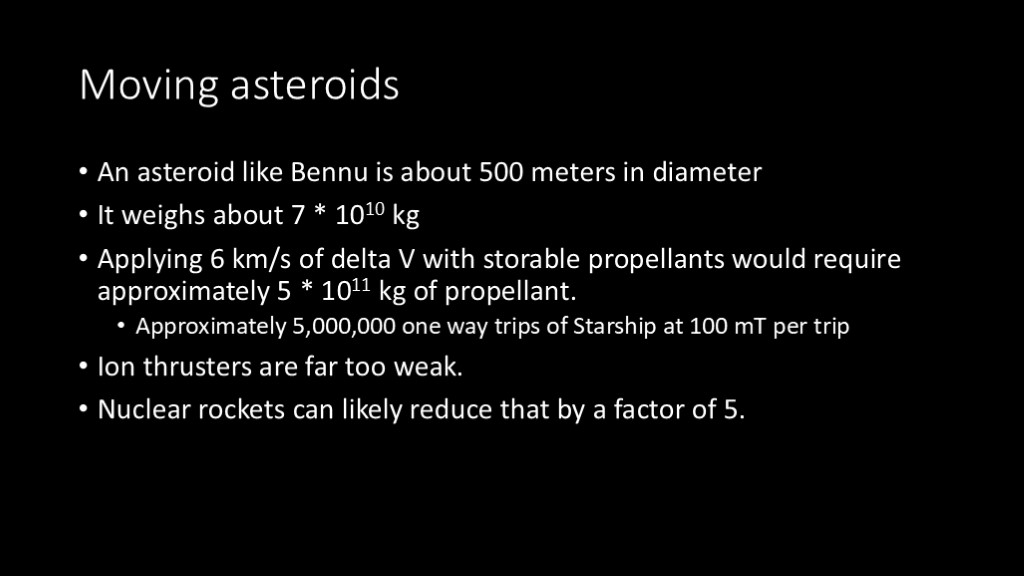
What about moving asteroids?
This is a really fun one.
The asteroid NASA caught up with for Osiris Rex is called Bennu and it's about 500 meters in diameter. It's a medium-sized asteroid; I could have chosen smaller or I could have chosen bigger.
It weights 7 times 10 to the 10 kilograms.
If we want to move that back with storable propellants, it requires approximately 5 time 10 to the 11th power kilograms of propellant. With starship carrying 100 metric tons that would be about 5 million one way trips.
You could consider using ion thrusters but ion thrusters are really really weak and good luck moving it even with storable propellants - the number of engines you need is unrealistic.
I'm sure someone is thinking that nuclear rockets would be great. Nuclear rockets can likely reduce that by a factor of 5 and that's good but that really doesn't help you out. You can obviously choose a much smaller asteroid it try moving it, and maybe that makes sense, but moving it takes us back to the problems we had just moving refined platinum back to earth; it's just not very easy to do and the less refined your material is, the more problematic it is.
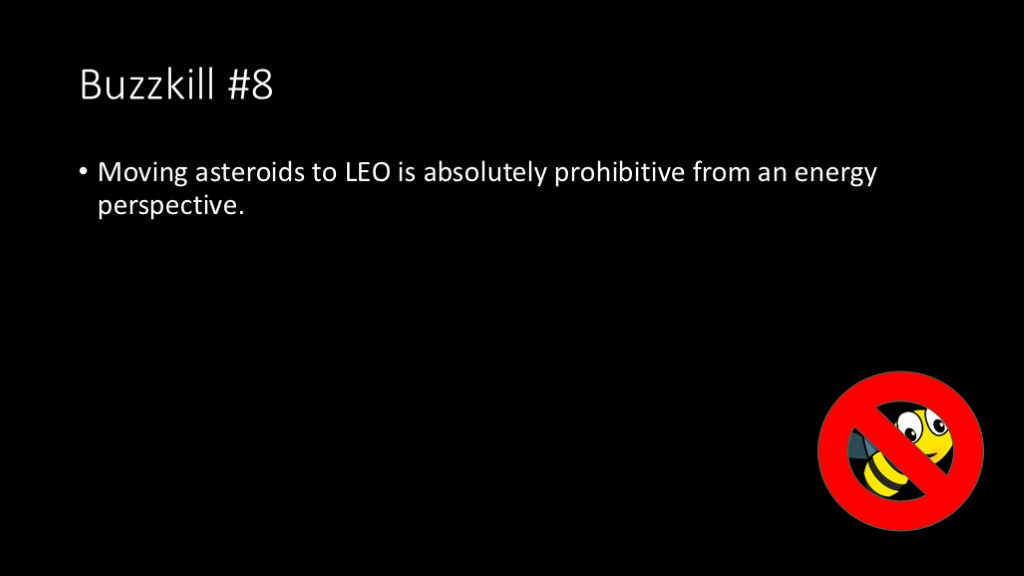
Buzz kill number eight - moving asteroids to low earth orbit is just prohibitive from an energy perspective - it's really really really hard.
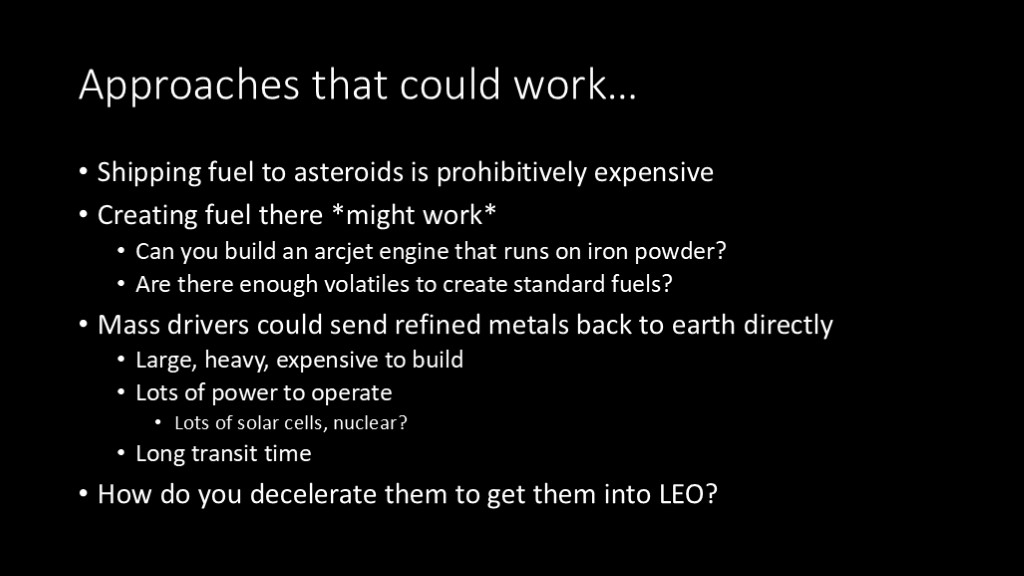
I've been a buzzkill this whole time...
I spent a little time thinking what sort of approaches might actually work. The problematic part is that shipping fuel to asteroids is prohibitively expensive and even if you are doing nuclear, nuclear needs fuel, ion thrusters need fuel, hypergolics need fuel, and just getting there is prohibitively expensive.
You need an approach where you don't need to ship it there. Would it work if you could create fuel there?
Maybe you could build something - there's something called an arcjet engine and maybe you can mine iron, convert it to powder, and use that to give you some sort of thrust. Even if it's not very efficient - even if it has a low specific impulse - the fact that your fuel is right there makes a huge difference in economics.
Or, maybe there are enough volatiles on the asteroids you choose to create standard fuels. This one might work, but I'm a little skeptical as you'll need significant infrastructure to gather those volatiles - which may be problematic itself - and then create fuels from it, but maybe that could work.
Another option that has been talked about instead of building vehicles we just put a mass driver on the asteroid and mass drivers just work on electrical power. You just build a sort of capsule out of something magnetic like asteroid iron and then you put the metals you want to send back inside of it and then you put it on the mass driver, and it just accelerates it up and sends it back to earth.
You probably need more than that - you probably need at least some sort of small rocket controls to do course corrections, but you can get rid of a lot of your delta v requirements by doing that.
Mass drivers are going to be large, heavy, and expensive to build. My guess is that the mass driver construction is going to be worse than the refinery construction; they take lots of power to operate, so the power that would be coming from fuels would now need to come from electricity, so you need lots of power - lots of solar, lots of video. You probably also have a long transit time.
You have two problems at the other end. First of all you have these small metal things coming towards low earth orbit and you need to decelerate them and that's problematic; you'd either need some sort of ship to latch onto them and then use normal fuels to decelerate them, and that would be possible.
You could consider doing aerobraking and that might be a great way to do this, but there's a significant problem there; aerobraking needs to be precise when means you need good navigation over long distances, and that's hard.
The problem is that a nice compact precious metal probe or container coming back works well and if you miss and end up too close to earth it functions as a pretty good kinetic energy weapon, and I'm not sure anyone would be excited about having a mass driver halfway across the solar system sending this long stream of packets towards us and if we don't catch them they can have a significant downside for those of us who live on earth.
I guess I can see that kind of working - a little more problematic - but probably easier than the other things we've talked about.
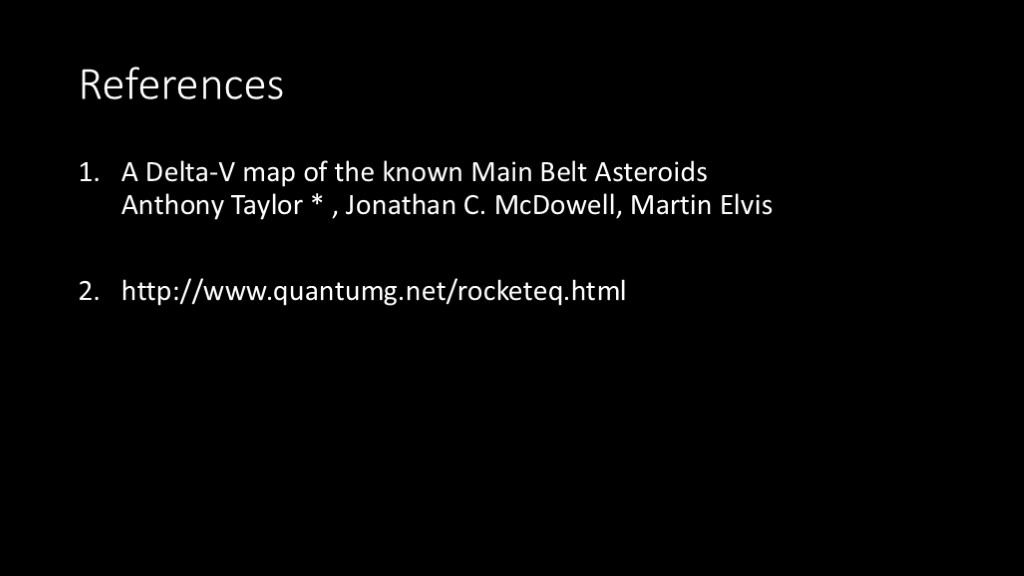
Here are the two references that I'd like to point you to:
The first one is the one I used for the reference mission and it's called "a delta v map of the known main belt asteroids" - you can go there and there's a lit of a whole bunch of asteroids and how much delta v it takes to get to each of them, and then there's a lot of other really interesting discussion there if you care about this sort of topic.
The second reference is the rocket equation calculator that I used and basically all you need to know to use the calculator what fuel you are using - or more importantly what specific impulse you'll get out of your fuel choice - and how much delta v you need, then you can just put in the mass - what you think your overall mass is - and it'll tell you what your dry mass is, and that's really interesting to play around with, so you can go and plat with that as well.
Thank you, and this has been asteroid mining buzzkill.